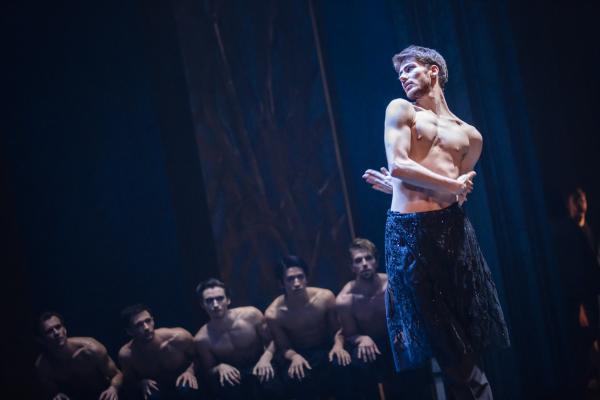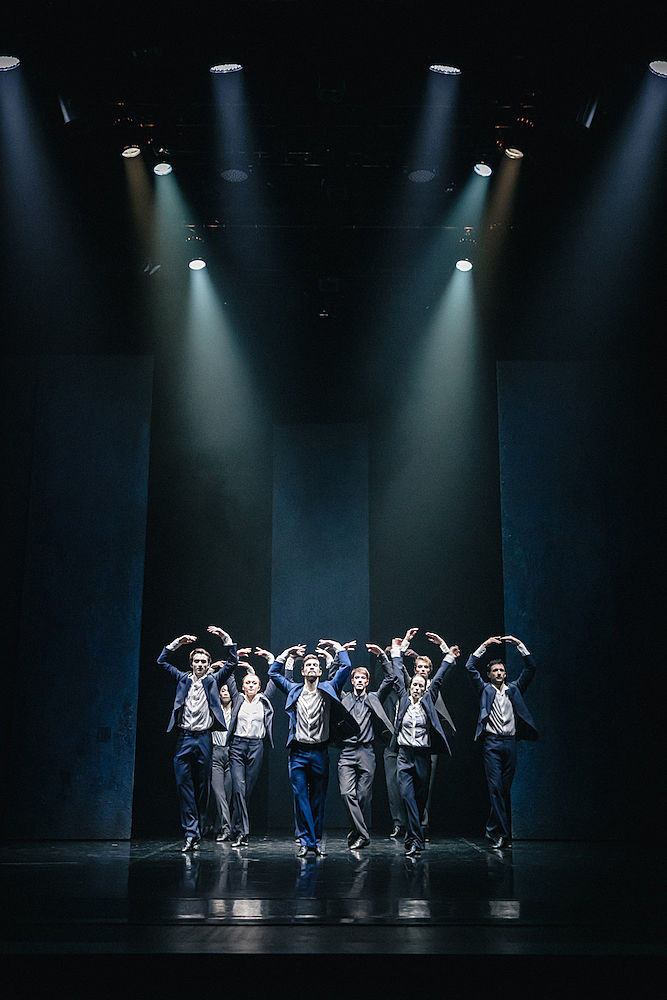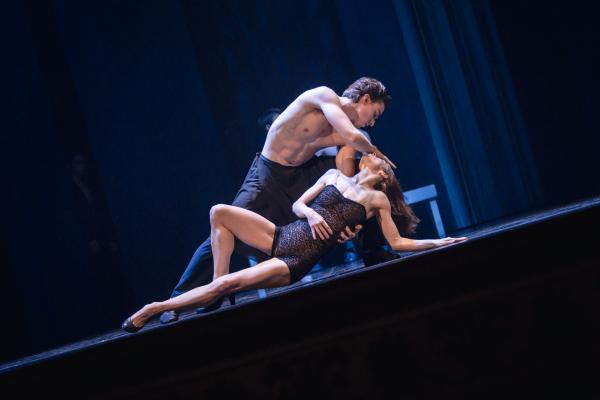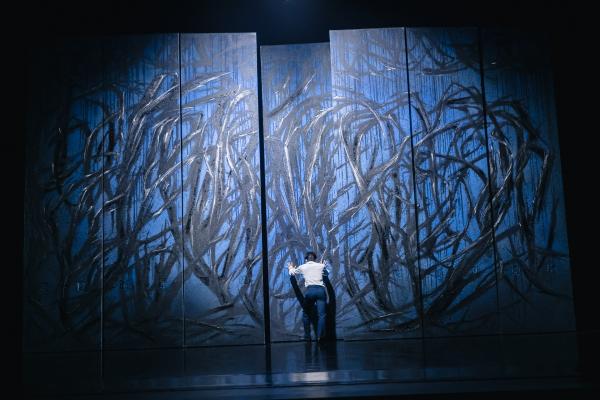If postmodern means something and something good, that is what Hélène Blackburn’s Les Beaux Dormants is, performed for a few nights only at the Royal Opera’s Linbury Theatre. A contemporary take rather than a re-telling of Sleeping Beauty, it is both a deconstruction and an exaltation of the fairy-tale and the classical ballet. Satire and homage mixed together.
One the many successes of Blackburn’s piece is that it can be relished at different levels, meeting different expectations and different kinds of audiences. Children can – and did – enjoy it, I sat next to a little girl whose mouth didn’t close throughout from sheer dazzlement; and adults, whether dance aficionados or newbies, have abstraction to bogle the mind and beauty to assuage their nerves.
The inherent intelligence of the work is to suffuse the whole 50 minutes of its duration (too short I thought!) with surface entertainment which is constantly surprising, capillary delight at the grace and beauty of the dancers of the Ballet of the Opera National du Rhin (OnR), and, at a deeper level, an argument – yes an argument! – for the independence of dance (from narrative, from history, from society’s norms) to express the ineffable mal-de-vivre of our times.
The work is in fact so thought-provoking and rich it would merit a book-length study – and would need to be viewed a number of times.

The tensions between classical and modern animate every moment of the piece giving it a perpetually renewed energy, alternating between satire and sublime.
This starts with a seemingly prosaic reflection on footwear: from point shoes, to flat soft shoes to high-heel power-woman shoes, not always in that order and especially not worn by the usual gender-wearer. Thus, a male dancer – the strikingly tall and elegant Cauê Frias – walks through the stage on a pair of woman’s high heeled shoes and at different moments dances on them as if he were born to them – that is when it stops being funny and moves towards the superb.
He is part of the eight dancers who are ‘the sleepers’, representing figures of horror and elation, despair and love who are phantasmagorical in the way their movements flow in a dynamic communication which moves from one to another through duets or exhibition solos. They accompany and illustrate the snippets of action indicated by the other five dancers who, at strategic points of the dance, play out the curse of the wicked fairy Carabosse, who puts the princess to sleep.
There is no linearity; it is not clear who does what, why and when – but dance is not about narrative. That is indeed for fairy-tales, or, incidentally – and not by chance – for the concomitant main stage show at the Royal Ballet, where the Royal Ballet dancers are performing Petitpa’s Sleeping Beauty. Blackburn’s piece is both a psychological drama and a representation of the clash between youth and life, with their world of possibles, confronted with the relentless moving forward of time.
The music by vant-guard turntable artist Martin Tetreault is a bonanza of hip-hop rhythms, R&B deep beats, electro-pop with collage insertions of the best-of from Tchaikovsky’s score. It is the perfect not so much accompaniment, as properly speaking, collaborator for the meta-representational quality of Blackburn’s work.

In the program booklet, there is a central article by John Snelson, the ROH’s in-house cultural historian, musing on the different metaphorical meanings of fairy-tales. Whilst there is of course, a place for reflecting on those questions, Blackburn’s work has gone far beyond digging the metaphor of the sleeping beauty. Like all great choreography, her work is about the meaning of dance.
The marriage of classical movements with the release and rebelliousness of modern moves: from loose shoulder swerves to disarticulated port-de-bras, where arms which should be round stick out at odd angles, is dramatized not by any kind of story-line or subliminal morality which so many fairy-tales rely on; rather, what comes out of it is a sense of liberation from rules and that the body wants and can do whatever it likes.
The role of the wicked fairy is embodied by a male dancer, Valentin Thuet, who wears a point shoe on his right foot and a soft flat shoe on his left. He has a skirt over trousers with a naked chest. He is half-male, half-female, half-dark, half-light, half-strong, half-weak, half-tortured, half-domineering. He twirls and stretches into beautiful contortions driving home to the spectator that he is not more the curser as the cursed: energy trapped in the limits of a body.

Sexuality, what it is, its naturalness and irresistibility, and at the same time the confusion it wreaks is another key theme explored in the most varied and intelligent ways throughout the piece.
First through the sexual neutrality of the dancers who start of all wearing the same modern grey business trouser suits, though the appearance of the high-heeled dancer is a first clue that gender-bending is key. The costumes soon become more defining, if not less disorienting, as the male dancers take off shirts, acquire skirts, take skirts off, put them back on, and the women get into super sexy black lace leotards.
Duets of ravishing speed and technicality between male and female dancers are equalled by man on man pas-de-deux’s with delicate lifts and an attention drawn to the slenderness rather than the strength of the male dancers’ bodies.
There is a fascination with and a questioning of the male dancer’s body throughout. There are no girl on girl duets. It is clearly the hybrid soul of the masculine which is being unfolded and uncovered: he is released from the classical norm of being the rock in pas-de-deux partnerings. He can now experiment in being the wooed and not only the wooer, in being lifted and flying for himself, in being loved and kissed.
If one were to follow Snelson’s fairy-tale metaphor reading, then Blackburn’s piece would be telling us that the princess slept for a hundred years because the prince wanted to have fun on his own and experiment with all sorts of partners including homosexual love, before getting back to her.
I am not sure that is Blackburn’s intent – but then again this is an example of the complexity and multi-layers of the piece. One thing is for sure, the bourgeois happy-ending marriage between a prince and his princess is chucked out of the window.

The kiss is a leitmotiv. That magic kiss the prince gives his princess to wake her is magnified here: it is multiplied horizontally across couples and sexual partnering, as also vertically in degrees of intensity of time and type: long embraces, a nip on the cheek, deep mouth-interlocking. There is an aesthetics of the kiss at work which is both amusing and cheeky, but also a celebration of the beauty and simplicity of that physical connection.
The kiss also participates in the general symphony of awakening: so many sleepers, so many awakenings. The title of the piece Les Beaux Dormants translates literally as the beautiful sleepers: all sexes included and not just a girl or many girls (who would have been ‘belles’). The twelve dancers are all in it together. Transcending again the limits of the fairy-tale, the dance is a shout-out to all of us to awake from an enforced sleep, and to mould our lives to our dreams.
Each and every dancer of the OnR is remarkable and each very unique and individual in their performance – another impactful liberation from the uniformity and conformity required of the dancers of the classical Sleeping Beauty.
The company’s full name is Opera National du Rhin-Opera d’ Europe – and this cannot go unmentioned in the absurd and tragic times that the UK is living at the moment, torn by the belief of some that it should detach itself from the rest of Europe. The first page of the programme opens with the title ‘European Ballet rooted in the 21st century’. Kudos to the ROH to openly display its allegiance, commitment and support to the cutting-edge art created from across the channel, which had been put forward also last month with the performance of the CCN-Ballet de Lorraine and the Compagnie Amala Dianor. European ballet lives, breathes and awes in London in 2019.
Reviewed at the Linbury Theatre on 23rd of November


